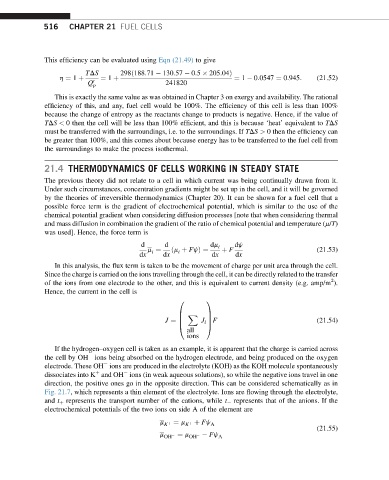Page 523 - Advanced thermodynamics for engineers
P. 523
516 CHAPTER 21 FUEL CELLS
This efficiency can be evaluated using Eqn (21.49) to give
TDS 298ð188:71 130:57 0:5 205:04Þ
h ¼ 1 þ ¼ 1 þ ¼ 1 0:0547 ¼ 0:945: (21.52)
Q 0 p 241820
This is exactly the same value as was obtained in Chapter 3 on exergy and availability. The rational
efficiency of this, and any, fuel cell would be 100%. The efficiency of this cell is less than 100%
because the change of entropy as the reactants change to products is negative. Hence, if the value of
TDS < 0 then the cell will be less than 100% efficient, and this is because ‘heat’ equivalent to TDS
must be transferred with the surroundings, i.e. to the surroundings. If TDS > 0 then the efficiency can
be greater than 100%, and this comes about because energy has to be transferred to the fuel cell from
the surroundings to make the process isothermal.
21.4 THERMODYNAMICS OF CELLS WORKING IN STEADY STATE
The previous theory did not relate to a cell in which current was being continually drawn from it.
Under such circumstances, concentration gradients might be set up in the cell, and it will be governed
by the theories of irreversible thermodynamics (Chapter 20). It can be shown for a fuel cell that a
possible force term is the gradient of electrochemical potential, which is similar to the use of the
chemical potential gradient when considering diffusion processes [note that when considering thermal
and mass diffusion in combination the gradient of the ratio of chemical potential and temperature (m/T)
was used]. Hence, the force term is
d d dm i dj
m ¼ ðm þ FjÞ¼ þ F (21.53)
i
i
dx dx dx dx
In this analysis, the flux term is taken to be the movement of charge per unit area through the cell.
Since the charge is carried on the ions travelling through the cell, it can be directly related to the transfer
2
of the ions from one electrode to the other, and this is equivalent to current density (e.g. amp/m ).
Hence, the current in the cell is
0 1
C
B X
J iCF (21.54)
B C
J ¼ B
all
@ A
ions
If the hydrogen–oxygen cell is taken as an example, it is apparent that the charge is carried across
the cell by OH ions being absorbed on the hydrogen electrode, and being produced on the oxygen
electrode. These OH ions are produced in the electrolyte (KOH) as the KOH molecule spontaneously
dissociates into K and OH ions (in weak aqueous solutions), so while the negative ions travel in one
þ
direction, the positive ones go in the opposite direction. This can be considered schematically as in
Fig. 21.7, which represents a thin element of the electrolyte. Ions are flowing through the electrolyte,
and t þ represents the transport number of the cations, while t represents that of the anions. If the
electrochemical potentials of the two ions on side A of the element are
m K þ ¼ m K þ þ Fj A
(21.55)
m OH ¼ m OH Fj A

